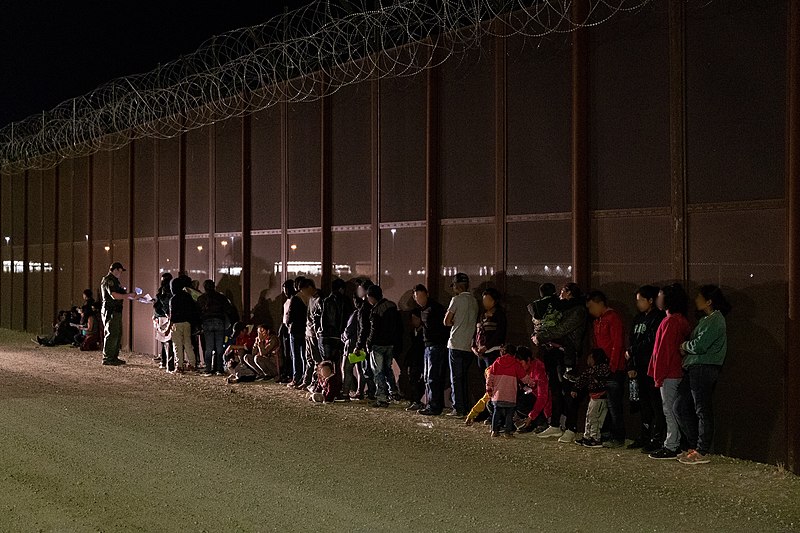Winner of the Fall 2019 StMU History Media Award for
Best Article in the Category of “Human Rights”
In 2019, the Trump administration passed a “zero-tolerance” policy that discouraged illegal immigration and strengthened legislation that allows U.S customs to separate children from their parents when they have enough information to prove families have entered the U.S illegally. But in reality, the Trump administration does not understand why more immigrants have been crossing the border, particularly why there has been an increase in women and children immigrating. Based on recent studies by the Migration Policy Institute, there has been an increase of 3.5 million of Central American immigrants since 2000. Many people believe that the increase in Central American immigrants has just been because women are seeking better jobs or economic opportunities to prosper.1
Instead, more than ninety percent of female immigrants have been trying to leave their home countries due to violent and heinous criminal acts occurring there. Many of these women had been living in fear, because people were trying to make them commit criminal acts. Many women were being forced to join a specific gang or sell for a particular cartel. In the worst case scenario, some females had gone missing if they didn’t obey their community gang. In that case, typically when women had gone missing, they had either been sold into prostitution or killed.2

These dangers facing women in their home countries are horrific. But, if someone were to ask a women who has attempted to cross the border, they would explain that escaping their country is the least of their dangers. The most dangerous part is the journey itself. Coming to America, especially if they don’t have a male companion, women fear “the coyote” (a person who smuggles Latin Americans in exchange for a high fee), because frequently they abuse women physically or mentally. Sometimes, they will attempt to kill either females or males just to get what they want if you don’t have enough money for their “couta” (the money needed before and after you attempt to cross). In the worst cases, women go missing or get sold to cartels instead of completing the journey into the U.S.3

On April 24, 2019, a migrant caravan came to the United States. Many migrants that arrived with the caravan had come from Central America. More than half of the migrant caravan were females, many fleeing their countries because of the endemic violence there. One human rights advocacy group reported that in January 2019, El Salvador and Honduras were two of the most violent countries in the world. This is significant because this statistic portrays that many migrants have no option but to flee their country either because of gang threats against their lives or because they face mass murder from the government.4 A prime example of this is a young women named Chavez, from San Marcos, Guatemala, where she witnessed a few of her colleagues being killed in gang violence, because they had refused to join the gang. She reported that she was also threatened by the same Guatemalan cartel for many years, due to her being a threat to their sales. Chavez was viewed as “threat,” because she talked to the another cartel, which happened to be their enemy. After the death of her colleagues, Chavez finally made a risky decision to come to the United States, no matter what consequences she might face. Women like Chavez mourn, “It breaks my heart, but I have to keep going.”5
In comparison, Carmen was a single mother who lived in Guatemala whose pilgrimage happened for different reasons. Carmen was willing to risk everything for her son to live a better life where she could offer Enrique an education past the sixth grade. Carmen was well aware that she would have to leave her children due to the expenses of crossing the border and possibilities of harm that lay ahead, but still she continued on her journey despite these costs. As she was crossing the border, she was brutally raped and robbed by her smuggler. It was hard for her to move past all the torture, but she had to continue forward for her kids. Once she arrived in the U.S., she noticed that it was harder to make an honest living than people thought. She didn’t earn enough money to attempt bringing her son across the border. Even though some women come to the states to make a better life for themselves and their families, these women still face lots of violence, which makes them second guess their decision in bringing their children with them. They don’t want to their children to go through the same traumatic experience that they did.6

In some cases, women who are expecting a child or are crossing with a child might actually want to get caught by customs as they cross the border. Many women who are crossing with their children tend to rely on others to help provide food and water for their kids on the journey. Because women can’t carry all the belongings necessary for their children to stay hydrated and healthy, they might want to get caught by U.S. customs agents so that they can get these necessities for their children in a center. For many women, even just stepping onto the U.S soil is a miracle. They don’t care if they get stopped, because they know that wherever they end up going is still dramatically better than where they had been living. But, in reality, many women do not understand what could happen to them within the walls of a detention center until they experience it first-hand. For example, one women from El Salvador was eight-and-a-half months pregnant and began to experience contractions. The women was in a detention center near the Rio Grande and she thought that she would be allowed to stay in the United States because she was pregnant, but the officials disagreed. Border agents took her to a hospital nearby, where the doctors gave her a medication that would stop her contractions. Right after her contractions were stopped, they sent her back to Mexico, where she was caught crossing. What pregnant people don’t understand is that they face more dangers than anyone in a detention center, because they don’t have access to regular meals, medical care, and clean water.7

On the other hand, some of the women who actually make it to American soil will temporarily live in a “safe house” (a house that contains people who were able to cross the border and these are often run by the coyotes). But the name is misleading. Even those in safe houses are still in danger. For instance, Melvin, a 36-year-old mother of three, lived in a safe house in McAllen, Texas, waiting for her family to gather enough money to get free from the house. She thought she was safe from harm, until one night the smugglers lost patience waiting for her to pay them. The smugglers took matters in their own hands, drugged her with pills and cocaine, and then locked Melvin in a room. Melvin was locked in the room for weeks. The men she paid to bring her safely bringing to the United States had betrayed her, spending weeks raping her. If she ever spoke a word of this, they threatened to beat her and kill her and every single person in her family.8
Some may ask why women come to the United States if they face deadly consequences along the way? Although the journey of coming to the United States can be life threatening, for many women nothing beats the desire to find physical and cultural well-being in the U.S. People not only seek financial security, they also seek freedom — the freedom that will allow them to raise their children without worries of them being force to join a certain gang or cartel. These women are tired of living in fear that one day their child might go missing because of gang violence in their community. Immigrants don’t come to America to “steal jobs;” they come to find safety no matter what the consequences can be to achieve this goal. Their determination and willingness is all these women need to believe that what they are trying to conquer is without a doubt the best move for not only them for their children as well.9
- Allison O’Connor, Jeanne Batalova, and Jessica Bolter, “Central American Immigrants in the United States,” Migration Information Source, August 15,2019, https://www.migrationpolicy.org/article/central-american-immigrants-united-states. ↵
- Anjali Fleury, “Fleeing To Mexico For Safety: The Perilous Journey For Migrant Women,” United Nations University, 2016, https://unu.edu/publications/articles/fleeing-to-mexico-for-safety-the-perilous-journey-for-migrant-women.html/. ↵
- Amanda Erickson, “Why do some families risk crossing the U.S. border? Because if they don’t, they’ll be killed,” The Washington Post, June 20, 2018, https://www.washingtonpost.com/ news/worldviews/wp/2018/ 06/20/why-do-some-families-risk-crossing-the-u-s-border-because-if-they-dont-theyll-be-killed/. ↵
- Salil Shetty, “Most Dangerous Journey: What Central American Migrants Face When They Try To Cross The Border,” Amnesty International, 2019, https://www.amnestyusa.org/most-dangerous-journey-what-central-american-migrants-face-when-they-try-to-cross-the-border/. ↵
- Kevin Sieff and Sarah Konosian, “Three women and their children made it to the border- but their fate still hang in limbo,” The Lily News, December 5, 2018, https://www.thelily.com/three-women-and-their-children-made-it-to-the-border-but-their-fate-still-hangs-in-limbo/. ↵
- Sonia Nazario, Enrique’s Journey: The Story of a Boy’s Dangerous Odyssey to Reunite with his Mother (Los Angeles: Random House, 2006), 4-10. ↵
- Norman Merchant, “A Heavily Pregnant Migrant Crossed the U.S. Border Experiencing Contractions.American Doctors Stopped her Labor, Then Sent Her Back to Mexico,” TIME, September 7, 2019, https://time.com/5671108/us-pregnant-migrants-labor-mexico/. ↵
- Manny Fernandez, “You Have to Pay With Your Body: The Hidden Nightmare of Sexual Violences on the Border,” The New York Times, March 3, 2019, https://www.nytimes.com/2019/03/03/us/border-rapes-migrant-women.html/. ↵
- Allison O’Connor,Jeanne Batalova,and Jessica Bolter “Central American Immigrants in the United States”, Migration Information Source, August 15,2019, https://www.migrationpolicy.org/article/central-american-immigrants-united-states ↵



50 comments
Ana Cravioto Herrero
This is a great article and you did an amazing job of describing the suffering these women go through. The backstories were very well written and it definitely reminds the reader that these immigrants are still human and that they are doing something illegal for a good reason. People need to start putting themselves in these women’s shoes and try to find a solution rather than automatically making them criminals.
Lesley Martinez
News outlets often portray the migration of Central American immigrants into the United States, as you said, for better jobs or economic opportunities. However, this is misleading and dismisses the true reasons there has been an upsurge of migrants seeking security. Living on a border town to Mexico, this is something I often heard about it. It is heartbreaking and at the same time eye-opening to read about the terrible experiences that women have to experience to enter the United States and escape such violence. This was great and necessary article and I hope it receives the recognition it deserves.
Madelynn Salinas
I have read many articles about immigration, but your article in particular speaks to me so much more because of the way you shared the backtstory to female immigrants. trump has painted this picture of criminals and “scary men” and your article reminds people that immigrants are victims themselves, many who are women trying to escape their dangerous life. It was very different and interesting to read, and I think you bring an important perspective!
Malik Heard
This was a very a controversial topic the article was on and I found it really interesting.It was well written and the article does a great job describing the suffering women go through to get across the border.The personal examples were great as well.I hope that these difficulties are one day fixed so migrants can have a easier time.
Cassandra Sanchez
This article does a great job explaining the effects on women when crossing the border. Many people come to the United States to find safety from what ever might be happening back where they are from, not all have bad intentions. These stories of the women give the reader an insight as to what they are going through and how it really is when they cross the border.
Pablo Ruiz
This is a really good article about a really important topic in our news today. I enjoyed how you used personal examples to show how dangerous the journey is for women and to highlight the problems on our southern border. People do not understand the adversity theses women are trying to escape from and how risking their lives to come to the US is better than staying in their current situation. This article does a good job showing that to people.
Dr Celine
You tell very important stories about a very high price to pay for even the hope of freedom and a semblance of safety that many actually do not find. These stories are important in understanding patterns and why recent hardships imposed on the people who have crossed are not effective in deterring people from attempting the journey when for many the worst torture and violations on the voyage is still much more bearable than an interminable life of violence and insecurity at home.
Jose Chaman
The topic that this article describes is a very sensitive issue. I found it really interesting, and a very good writing strategy, to present testimonies of women who have gone through these situations at the borders. I hope that these difficulties can be overcome, and that security improves for the sake of dignity and integrity. It is an excellent article.
Sebastian Azcui
This is one of the most controversial themes right now and a current event that a lot of people around America and the world are aware of. This article does a great job in showing how women suffer and struggle by crossing the US-Mexico border. Most of the women that do this do not do it to steal jobs and be an illegal not doing anything. Many women just do it to find protection and be safe.
Courtney Pena
I thought that it was interesting how there were personal examples of female migrants trying to cross the U.S Mexico border. This article truly connects to my SMC class since we are talking about borderlands. It does an amazing job at showing that women face struggles while crossing the U.S Mexico border and that they come to America for protection and not to steal jobs.